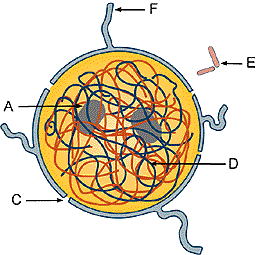
In this lesson you will learn the structure and function of the eukaryote nucleus. The terminology and descriptions will help you in understanding the next lesson cell cycle.

Advanced eukaryote cells exhibit two types of cell division - mitosis and meiosis. Mitosis produces two daughter cells that have exactly the same genetic information as the parent cell. This genetic information is carried on chromosomes which are exact copies of the chromosomes of the parent cell. Meiosis produces four daughter cells that have one half of the genetic material as the parent cell because they have only one of each chromosome pair found in the parent cell. Meiosis occurs only in the reproductive organs of organisms consisting of eukaryotic cells. Write a brief description contrasting between mitosis and meiosis. Both mitosis and meiosis involve the replication of DNA (located on chromosomes) and segregation into two separate groups. The initial stage of cell division involves DNA condensing to form chromosomes which will be located in the nucleus of the eukaryotic cells and consist of DNA surrounded by protein (histones). The red and black linear structures in the nucleus above represents DNA molecules. Read behavioral objective 2 and study the pages indicated by G-2.

Examine the figure above and identify the following labeled parts the nucleus: nuclear envelope, nuclear pores, chromatin, nucleoli, centriole pair, endoplasmic reticulum. Recall that one of the differences between higher plant cells and animal cells is the presence of centrioles near the nucleus of the animal cells. In your notes write a function in the working cell for each of these structures.
Click here to check your answers to the labeled parts of the nucleus.
For information on how to use this page, go to How to Use This Site.
Created by the Center for Learning Technologies, Academic Technology Services.
Last modified October 22, 1997.